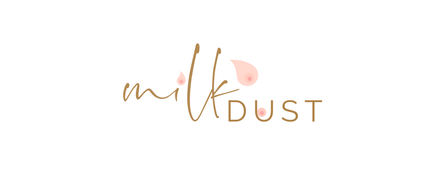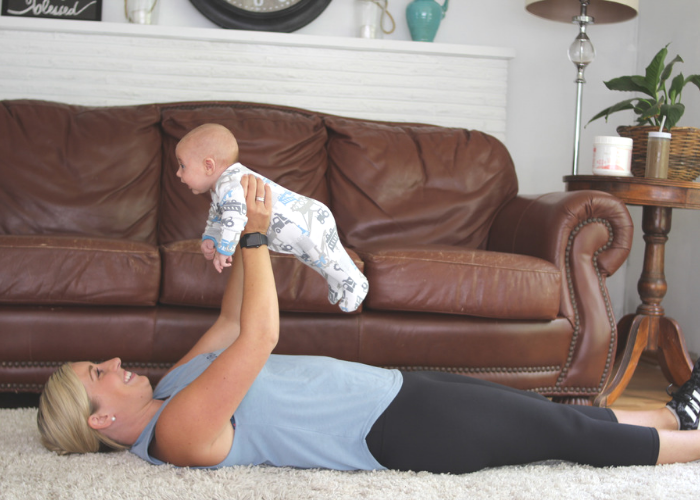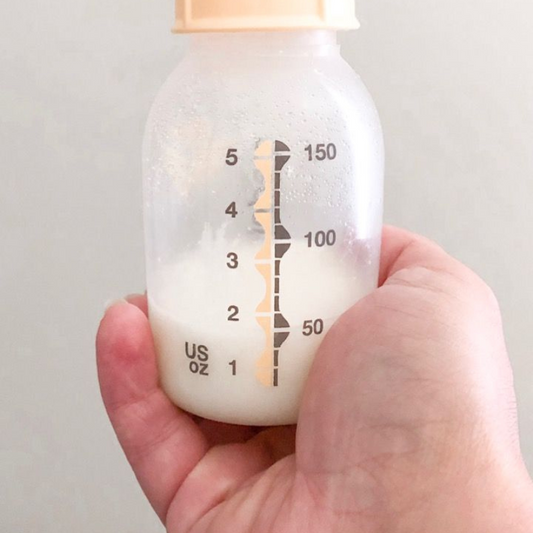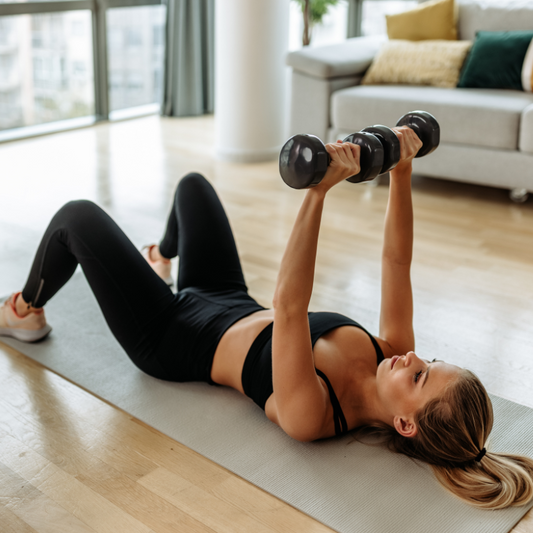Postpartum exercises are very important to healing and correcting the ab separation that is natural during pregnancy. Many mothers are sent home from the hospital with a sheet of simple exercises with little explanation.
As new research and expertise develops in the field of postpartum recovery, new exercises emerge as the top exercises you can do at home to help you heal your mommy pooch. Here at Milk Dust, we encourage healing postpartum through supporting your body with proper nutrition. We also believe firmly in a well-rounded approach to healing that involves caring for your body through healing and corrective movements. Correcting diastasis recti isn't the full store of getting rid of the mommy pooch. Much of the pooch is also losing weight while breastfeeding, which we have an in-depth post on how to do that as well.
What is Diastasis Recti?
Before we get started on the moves to correct abdominal separation, it is important to fully understand what it is. During pregnancy, the abdominal wall muscles separate to allow room for the growing uterus and baby. Pregnancy hormones allow the internal organs also move around to fit the growing baby. The linea alba is the mesh or connective tissue holding these muscles under the belly button together. When the connective tissue stretches, it can make it more difficult for the deep abdominal muscles to come back together. After the baby is born, breastfeeding stimulates the uterus to contract back to its normal size. As the uterus contracts, the ab muscles can come back together as well. This process takes time, and it is normal to have 3-4 finger widths of separation in the deep core muscles. Diastasis recti is when this separation doesn't get smaller, and the deep hole remains a few fingers wide. A physical therapist can help you diagnose your diastasis recti, and physical therapy is always helpful for healing. The good news is that there are some exercises you can do aat home to help your body heal the ab separation.
Multiple pregnancies means you need these exercises even more:
Having multiple pregnancies causes the thin tissue or fascia that holds your abs together to weaken. Because the fascia gets stretched it isn't able to hold your abdominal muscles together as closely. Without the extra pull of the mesh between your inner abs, there can be a remaining pooch after multiple babies. This can be rectified to a smaller gap with continuous posture and exercise work, and it is most beneficial to do these in the beginning.
GET THE BRAND-NEW 8-WEEK MOMMY POOCH WORKOUT CHALLENGE!
Lose the mommy pooch from the inside out (inner core strength!).
It is very difficult to see the abdominals and diagnose diastasis recti with extra belly fat. Our protein shake helps with weight loss and milk supply, so you can heal your diastasis recti, while also losing some of the pooch!
Signs you have Diastasis Recti
Postpartum women will experience some of these signs if they have diastasis recti.
Lower back pain
Abdominal pressue
Poor posture
Upper body weakness
Pubic bone soreness
Weak pelvic floor muscles
Nutrition for healing connective tissue and diastasis recti:
Nutrition is just as important as the home exercises below. Nutrition has the power to help heal the connective tissue that holds the transverse abdominals together. These tissues need support to repair themselves post-pregancy. Eating a healthy diet full of protein, fruits and vegetables is key to supporting the healing process. A San Diego Center for Health paper called “Nutrition for Soft Tissue Recovery” cites the following vitamins necessary for soft tissue repair: vitamins A, B1, B2, B3, B5, B6, B7, B9, B12, C, D, E and K. It also lists the following minerals as necessary to the process: Calcium, Magnesium, Sodium, Potassium, Iron, Zinc, Selenium, Manganese and Copper (in small doses). Milk Dust offers all these essential nutrients to help with healing, while also providing milk-boosting herbs. It tastes amazing, and it is so easy to mix up with your favorite milk, coffee or smoothie blend!
I have a lot more resources for you, including recipe books, and products that can help you achieve your goals without sacraficing your milk supply at all!
If you want more help to lose weight, I have a great Breastfeeding Weight Loss + Fitness Pack that has EVERYTHING you need to lose the baby weight safely.
I give you $100 back if you lose 10lbs, so you have nothing to lose!
The Top 5 Best Exercises To Close The Gap

Standing Vacuum Breaths:
It is very important to practice these vacuum breaths while standing because standing is a functional position. Starting position is standing with feet shoulder-width apart, pelvis in a neutral position and relaxed shoulders. Take a deep breath in, and as you exhale pull your abs in as far as you can and hold. Hold as long as you before taking another inhale. Relax on the inhale, pull your abs in on the exhale. Make sure you are filling your lungs in your rib cage with air when you inhale. Perform 10-20 of these every morning. You can do them in the shower or while watching TV.
Pelvic Tilts:
Pelvic tilts are very helpful to retraining the abdominal muscles to come back together. Start by lying on your back with knees bent and feet hip-width apart and neutral spine. Let your arms lie next to your sides. Take a deep breath in, then as you exhale, pull your abs in and tuck your pelvis in. Think of zipping up your abs and hold. Then relax your pelvis back down as you inhale again. The key is to contract your abs as you exhale on all the moves. Do 10-20 of these every morning. This will improve your core strength overall, and you can start this exercises just 1-2 weeks postpartum.
Heel Slides:
After your pelvic tilts, while still lying on your back, slide one heel out, so your right leg is in a straight line. This is done on the exhale. Inhale as you bring your heel back in. While you exhale and extend the other heel, pull your abs in and control your pelvis. You can use a towel or wear socks to make the heel slide easier. Do 10 slides on each leg.
Bridges:
Continuing on your back, after your heel slides, you can go right into bridges. Start exactly as you are doing a pelvic tilt, but as you tilt bridge your hips up into the air and hold there. You can take deep breaths at the top, keeping your hips up, then exhale, pull your abs in and slowly bring your body back down, one vertebrae at a time. Moving slowly back down allows you to practice controlling the movement with your abs. This is reinforcing the mind-muscle connection that is essential for repair.
Posture Work Against Wall:
For this exercise, you want to go back to standing and use a wall to help. Learning proper posture and good form again after baby arrives is really important to strengthening the abs. When standing against the wall, slide your heels back so they are touching the wall, Roll your shoulders back to touch the wall as well. Pull your upper abdominal muscles in, but do not tuck your pelvis under. There should be a small gap between the wall and your lower back where there is a natural arch. Practice your vacuum breaths in this position. Make sure the back of your head is back touching the wall as well. During pregnancy and holding a new baby tends to pull our necks and shoulders forward and encourage a slouch and pooch. This helps correct that.
Additional home exercises you can add to your exercise routine:
Side plank: Lie on your side with your knees and hips stacked, while also propped up on your elbow. Pull your hips up, and exhale to pull your entire core in. Inhale as you drop your hips back down. Try to hold your hips up for about 10 seconds at a time and build up.
Toe taps: Go back to your pelvic tilt position. Raise both legs from your hips, so your lower leg is parallel with the floor. Lower one leg at a time, and tap your toe to the floor, then pull it back into place. Switch legs and hold your core tight, keeping your back from arching as you alternate tapping.
Squats: Strenghtening the glutes and legs will support your core. Stand with feet shoulder-width apart, sit back like you are sitting in a chair, then raise back up.
Lunges: You can do these with light weights as you get the okay from your doctor. Take a big step forward and lunge down with your right leg, then lunge forward with the left. You can walk and lunge.
Kegels: These will connect your pelvic floor muscles to your core. Lie on your back, take a deep breath in, and as you exhale pull your pelvic floor muscles in.
Consistency is key with these exercises.
The only way for these exercises to be truly beneficial is to be done consistently over weeks and months. It was 9 months of stretching, and more if you've had more babies. This is a natural trauma to the abs, that requires consistent restorative work. Adding this work into your workout routine as a warm up will bring the best results. If you are newly postpartum, creating a morning routine with these exercises will help repair the separation faster and develop more strength for exercising again after 6 weeks.
What if you have an umbilical hernia?
An umbilical hernia is a common condition that happens after pregnancy. It is a condition that needs to be looked at by your doctor, and you want to avoid heavy lifting until you do. Some umbilical hernias can cause issues and pain, while others you wouldn't even know they are there.
You can start your diastasis recti exercise program soon after birth, as long as you don't have too much low back pain, and your doctor advises you it is okay if you had a c-section delivery. It is a good idea to ask about any concerns you may have. New moms are always hoping these exercises will be effective right away, but because there was so much abdominal pressure for 9 months, it takes consistency and time to heal the deepest abdominal muscle. These best diastasis recti exercises are therapeutic exercises, meaning they work to repair damage. It takes time and patience to build a strong core during the postpartum period.
Losing fat is also essential to reducing the mom pooch
Weight gain during pregnancy is also a contributor to ab separation. If the extra weight stays for months after delivery, it pulls on the muscles, making it harder for them to repair. Gentle exercises will help, but losing the extra weight on the belly will help tremendously as well. The skin won't go away, but the fat can, and it is possible to lose weight while breastfeeding. Milk Dust is the perfect protein powder to help you lose the weight and keep up your milk supply.




